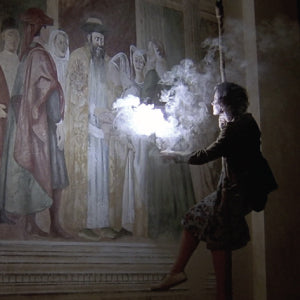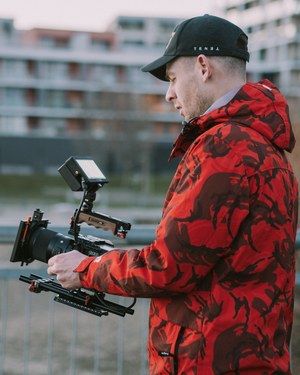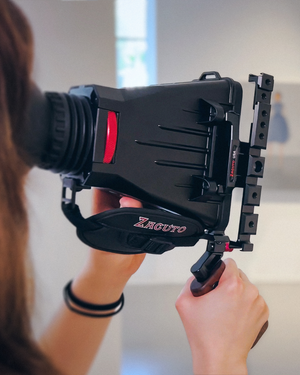
Lessons from a Master – John Seale, ASC ACS
This 5th installment in my Art Direction series is rather timely considering my recent attendance of a fantastic, uber informative and amazing masterclass by mentor and cinematographer John Seale, ASC ACS. The session was packed with incredible anecdotes and tips alongside scene analysis for films he has lensed. I think I learned more in 4 hours with him than I have in the past 4 years!
John Seale’s IMDB page reads like a Cinematographers dream. To name just a few of his amazing films, he worked as Cinematographer or Director of Photography on…
Mad Max: Fury Road -2015
 The Tourist - 2010
Poseidon - 2006
Cold Mountain - 2003
Harry Potter and the Sorcerer's Stone - 2001
The Perfect Storm - 2000
The Tourist - 2010
Poseidon - 2006
Cold Mountain - 2003
Harry Potter and the Sorcerer's Stone - 2001
The Perfect Storm - 2000
 The Talented Mr. Ripley - 1999
City of Angels - 1998
The English Patient -1996
Lorenzo's Oil - 1992
Dead Poets Society - 1989
Rain Man - 1988
John Seale is a man overflowing with information and experience. His generosity in sharing his knowledge is the hallmark of a true master craftsman.
I’d like to share two of his lessons with you here today.
1. The importance of improvising and being resourceful on set.
2. Teamwork - working with your gaffer, set design, prop department and whole crew to achieve a common goal.
To illustrate these points, let’s look at two scenes – one from The English Patient on which John Seale, ASC ACS, was Director of Photography, and one of mine. Don’t worry, I’m not implying that I compare the masterstroke of John Seale’s to that of my own feeble attempt. I’m merely using his example as a basis to reinforce some of the principles I’ve adopted in my own work.
Both of these scenes involve potentially hazardous props for both actors and crew. Let’s see how the set was kept safe, without losing the integrity of the shot, through creative problem solving and teamwork.
The Talented Mr. Ripley - 1999
City of Angels - 1998
The English Patient -1996
Lorenzo's Oil - 1992
Dead Poets Society - 1989
Rain Man - 1988
John Seale is a man overflowing with information and experience. His generosity in sharing his knowledge is the hallmark of a true master craftsman.
I’d like to share two of his lessons with you here today.
1. The importance of improvising and being resourceful on set.
2. Teamwork - working with your gaffer, set design, prop department and whole crew to achieve a common goal.
To illustrate these points, let’s look at two scenes – one from The English Patient on which John Seale, ASC ACS, was Director of Photography, and one of mine. Don’t worry, I’m not implying that I compare the masterstroke of John Seale’s to that of my own feeble attempt. I’m merely using his example as a basis to reinforce some of the principles I’ve adopted in my own work.
Both of these scenes involve potentially hazardous props for both actors and crew. Let’s see how the set was kept safe, without losing the integrity of the shot, through creative problem solving and teamwork.

 While the HMI LED equivalent Fresnels bathed the background in “moonlight” and backlit the actors, my main key light source was going to be the open fire.
Australian bushland and forest populated areas are extremely prone to fires due to the dry heat, which meant that we couldn’t and were not authorized to light an actual fire.
While the HMI LED equivalent Fresnels bathed the background in “moonlight” and backlit the actors, my main key light source was going to be the open fire.
Australian bushland and forest populated areas are extremely prone to fires due to the dry heat, which meant that we couldn’t and were not authorized to light an actual fire.
 So, we improvised! After a short emergency discussion with my AC, Gaffer, and the art department, we came up with the idea to conceal 3 small tungsten balanced LED lights behind a rocky man-made fire pit. We mounted a mini cookie carved out of cardboard on a pulley system comprising of string and branches. This allowed the operator to toggle the cookie across the light source to simulate flicker from an actual fire.
The result was a key light that suggested an open fire look. Our improvised ‘fire’ also allowed the actors to focus on the performance and play off the light source with minimal heat or discomfort.
So, we improvised! After a short emergency discussion with my AC, Gaffer, and the art department, we came up with the idea to conceal 3 small tungsten balanced LED lights behind a rocky man-made fire pit. We mounted a mini cookie carved out of cardboard on a pulley system comprising of string and branches. This allowed the operator to toggle the cookie across the light source to simulate flicker from an actual fire.
The result was a key light that suggested an open fire look. Our improvised ‘fire’ also allowed the actors to focus on the performance and play off the light source with minimal heat or discomfort.
 So there you go folks, the trials and tribulations of life of set! Somehow the magic happens when we make the most of what we’ve got, work together, and think outside the box. As they say, necessity is the mother of invention.
*****
Read the rest of the series!
Read Part 1 here: Introduction
Read Part 2 here: What is Art Direction?
Read part 3 here: 3 Art Direction Tips for Productions on a Budget
Read Part 4 here: Graphic Novel Inspiration: Frank Miller and Zack Snyder
Read Part 6 here: 4 Lessons from a Film Set
So there you go folks, the trials and tribulations of life of set! Somehow the magic happens when we make the most of what we’ve got, work together, and think outside the box. As they say, necessity is the mother of invention.
*****
Read the rest of the series!
Read Part 1 here: Introduction
Read Part 2 here: What is Art Direction?
Read part 3 here: 3 Art Direction Tips for Productions on a Budget
Read Part 4 here: Graphic Novel Inspiration: Frank Miller and Zack Snyder
Read Part 6 here: 4 Lessons from a Film Set

 The Tourist - 2010
Poseidon - 2006
Cold Mountain - 2003
Harry Potter and the Sorcerer's Stone - 2001
The Perfect Storm - 2000
The Tourist - 2010
Poseidon - 2006
Cold Mountain - 2003
Harry Potter and the Sorcerer's Stone - 2001
The Perfect Storm - 2000
 The Talented Mr. Ripley - 1999
City of Angels - 1998
The English Patient -1996
Lorenzo's Oil - 1992
Dead Poets Society - 1989
Rain Man - 1988
John Seale is a man overflowing with information and experience. His generosity in sharing his knowledge is the hallmark of a true master craftsman.
I’d like to share two of his lessons with you here today.
1. The importance of improvising and being resourceful on set.
2. Teamwork - working with your gaffer, set design, prop department and whole crew to achieve a common goal.
To illustrate these points, let’s look at two scenes – one from The English Patient on which John Seale, ASC ACS, was Director of Photography, and one of mine. Don’t worry, I’m not implying that I compare the masterstroke of John Seale’s to that of my own feeble attempt. I’m merely using his example as a basis to reinforce some of the principles I’ve adopted in my own work.
Both of these scenes involve potentially hazardous props for both actors and crew. Let’s see how the set was kept safe, without losing the integrity of the shot, through creative problem solving and teamwork.
The Talented Mr. Ripley - 1999
City of Angels - 1998
The English Patient -1996
Lorenzo's Oil - 1992
Dead Poets Society - 1989
Rain Man - 1988
John Seale is a man overflowing with information and experience. His generosity in sharing his knowledge is the hallmark of a true master craftsman.
I’d like to share two of his lessons with you here today.
1. The importance of improvising and being resourceful on set.
2. Teamwork - working with your gaffer, set design, prop department and whole crew to achieve a common goal.
To illustrate these points, let’s look at two scenes – one from The English Patient on which John Seale, ASC ACS, was Director of Photography, and one of mine. Don’t worry, I’m not implying that I compare the masterstroke of John Seale’s to that of my own feeble attempt. I’m merely using his example as a basis to reinforce some of the principles I’ve adopted in my own work.
Both of these scenes involve potentially hazardous props for both actors and crew. Let’s see how the set was kept safe, without losing the integrity of the shot, through creative problem solving and teamwork.
The English Patient
In the following Cathedral scene taken from The English Patient, Kip (Naveen Andrews) shows Hana (Juliette Binoche) some paintings in a very unorthodox way. Kip puts Hana in a harness and lifts her in a hoist armed only with a flare to view them in the darkness. With only one motivational light source from the window and some fill on the floor of the space, the flare was meant to be the key light source for Juliette Binoche’s character. But as John Seale explained, the production design department had provided actual flares for the scene. Flare emissions can burn and the fumes are carcinogenic. So upon insistence for the safety of the crew and Juliette, John and his gaffer came up with a prop that simulated a lit flare with a small light and vapor emitter installed in the tube. Running up the rope in Naveen Andrew’s right hand are internal cables that are powering both the light and smoke emitter. This solution meant that Juliette could hold the “flare” closer and higher to her face, thus fulfilling its purpose to have her photographed and exposed properly, and more importantly, beautifully.
Pop-Up
The following frame grabs show an exterior we shot in the middle of summer in the countryside of Newcastle, New South Wales, Australia. In this scene from “bloodgate” in Pop-Up, actors May Grehan and Tom Dalzell play a couple camping in the woods. The scene involves both of them sitting in front of a lit fire. While the HMI LED equivalent Fresnels bathed the background in “moonlight” and backlit the actors, my main key light source was going to be the open fire.
Australian bushland and forest populated areas are extremely prone to fires due to the dry heat, which meant that we couldn’t and were not authorized to light an actual fire.
While the HMI LED equivalent Fresnels bathed the background in “moonlight” and backlit the actors, my main key light source was going to be the open fire.
Australian bushland and forest populated areas are extremely prone to fires due to the dry heat, which meant that we couldn’t and were not authorized to light an actual fire.
 So, we improvised! After a short emergency discussion with my AC, Gaffer, and the art department, we came up with the idea to conceal 3 small tungsten balanced LED lights behind a rocky man-made fire pit. We mounted a mini cookie carved out of cardboard on a pulley system comprising of string and branches. This allowed the operator to toggle the cookie across the light source to simulate flicker from an actual fire.
The result was a key light that suggested an open fire look. Our improvised ‘fire’ also allowed the actors to focus on the performance and play off the light source with minimal heat or discomfort.
So, we improvised! After a short emergency discussion with my AC, Gaffer, and the art department, we came up with the idea to conceal 3 small tungsten balanced LED lights behind a rocky man-made fire pit. We mounted a mini cookie carved out of cardboard on a pulley system comprising of string and branches. This allowed the operator to toggle the cookie across the light source to simulate flicker from an actual fire.
The result was a key light that suggested an open fire look. Our improvised ‘fire’ also allowed the actors to focus on the performance and play off the light source with minimal heat or discomfort.
 So there you go folks, the trials and tribulations of life of set! Somehow the magic happens when we make the most of what we’ve got, work together, and think outside the box. As they say, necessity is the mother of invention.
*****
Read the rest of the series!
Read Part 1 here: Introduction
Read Part 2 here: What is Art Direction?
Read part 3 here: 3 Art Direction Tips for Productions on a Budget
Read Part 4 here: Graphic Novel Inspiration: Frank Miller and Zack Snyder
Read Part 6 here: 4 Lessons from a Film Set
So there you go folks, the trials and tribulations of life of set! Somehow the magic happens when we make the most of what we’ve got, work together, and think outside the box. As they say, necessity is the mother of invention.
*****
Read the rest of the series!
Read Part 1 here: Introduction
Read Part 2 here: What is Art Direction?
Read part 3 here: 3 Art Direction Tips for Productions on a Budget
Read Part 4 here: Graphic Novel Inspiration: Frank Miller and Zack Snyder
Read Part 6 here: 4 Lessons from a Film Set



Leave a comment